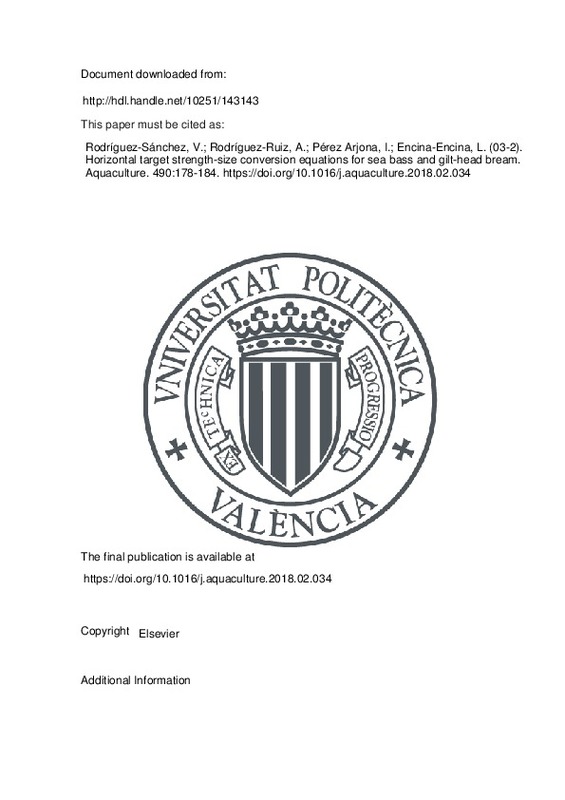JavaScript is disabled for your browser. Some features of this site may not work without it.
Buscar en RiuNet
Listar
Mi cuenta
Estadísticas
Ayuda RiuNet
Admin. UPV
Horizontal target strength-size conversion equations for sea bass and gilt-head bream
Mostrar el registro sencillo del ítem
Ficheros en el ítem
| dc.contributor.author | Rodríguez-Sánchez, V.
|
es_ES |
| dc.contributor.author | Rodríguez-Ruiz, A.
|
es_ES |
| dc.contributor.author | Pérez Arjona, Isabel
|
es_ES |
| dc.contributor.author | Encina-Encina, L.
|
es_ES |
| dc.date.accessioned | 2020-05-14T03:05:12Z | |
| dc.date.available | 2020-05-14T03:05:12Z | |
| dc.date.issued | 2018-03 | es_ES |
| dc.identifier.issn | 0044-8486 | es_ES |
| dc.identifier.uri | http://hdl.handle.net/10251/143143 | |
| dc.description.abstract | [EN] Horizontal hydroacoustics is a technique of remote fish detection that has proved to efficiently determine fish density and biomass in shallow or superficial waters. This non-intrusive technique could render better results than those obtained by conventional sampling when monitoring shallow waters. To apply this technique, we need equations that relate the amount of sound returned by fish, known as target strength (TS in dB), with their length (mm) or weight (g). This study presents horizontal conversion equations for the species gilt-head bream (Sparus aurata) and sea bass (Dicentrarchus labrax), two of the most important species bred in aquaculture. Moreover, this study presents a new formula to calculate a mixed equation adjusted to the percentage of distribution of those species in case of mixed populations. The results in this research have been obtained by applying a simple setup that allows for high-quality acoustic data. These new equations will enable the application of this technique in order to estimate these species' density and biomass in shallow aquatic systems such as aquaculture ponds with semi-intensive production densities. | es_ES |
| dc.description.sponsorship | This study's authors would like to thank the Superintendent of Economy and Knowledge (Andalusian Government) for the funding provided as part of the project (PI_57052) developed in collaboration with CTAQUA. We would like to thank the researchers Carlos Orduna Marin and Juan Ramon Cid Quintero for their selfless work to obtain the field data and to the company PIMSA for generously allowing us to use their facilities and fish. We would also like to thank the veterinarian JR Rodriguez for being kind enough to perform X-rays on the studied fish and Cristina Ocana for her careful proofreading of the English text. | es_ES |
| dc.language | Inglés | es_ES |
| dc.publisher | Elsevier | es_ES |
| dc.relation.ispartof | Aquaculture | es_ES |
| dc.rights | Reconocimiento - No comercial - Sin obra derivada (by-nc-nd) | es_ES |
| dc.subject | Hydroacoustic | es_ES |
| dc.subject | Target-strength equation | es_ES |
| dc.subject | Sea bass | es_ES |
| dc.subject | Gilt-head bream | es_ES |
| dc.subject | Aquaculture | es_ES |
| dc.subject.classification | FISICA APLICADA | es_ES |
| dc.title | Horizontal target strength-size conversion equations for sea bass and gilt-head bream | es_ES |
| dc.type | Artículo | es_ES |
| dc.identifier.doi | 10.1016/j.aquaculture.2018.02.034 | es_ES |
| dc.relation.projectID | info:eu-repo/grantAgreement/Junta de Andalucía//PI_57052/ES/Sistema no invasivo para la determinación de la biomasa total en sistemas de producción de peces/ | es_ES |
| dc.rights.accessRights | Abierto | es_ES |
| dc.contributor.affiliation | Universitat Politècnica de València. Departamento de Física Aplicada - Departament de Física Aplicada | es_ES |
| dc.description.bibliographicCitation | Rodríguez-Sánchez, V.; Rodríguez-Ruiz, A.; Pérez Arjona, I.; Encina-Encina, L. (2018). Horizontal target strength-size conversion equations for sea bass and gilt-head bream. Aquaculture. 490:178-184. https://doi.org/10.1016/j.aquaculture.2018.02.034 | es_ES |
| dc.description.accrualMethod | S | es_ES |
| dc.relation.publisherversion | https://doi.org/10.1016/j.aquaculture.2018.02.034 | es_ES |
| dc.description.upvformatpinicio | 178 | es_ES |
| dc.description.upvformatpfin | 184 | es_ES |
| dc.type.version | info:eu-repo/semantics/publishedVersion | es_ES |
| dc.description.volume | 490 | es_ES |
| dc.relation.pasarela | S\364935 | es_ES |
| dc.contributor.funder | Junta de Andalucía | es_ES |







![[Cerrado]](/themes/UPV/images/candado.png)

